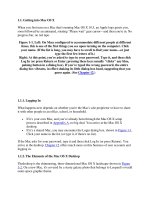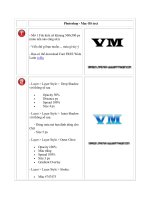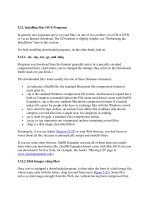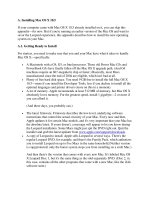17 2 redoing mac OS xs graphics
Bạn đang xem bản rút gọn của tài liệu. Xem và tải ngay bản đầy đủ của tài liệu tại đây (28.75 KB, 5 trang )
17.2. Redoing Mac OS X's Graphics
The professional interface artists at Apple use Adobe Photoshop, just like professional
artists everywhere else. But in Mac OS X, they've made very little effort to cover their
tracks. In Cocoa programs and even a few Carbonized ones, every element of the famous
Aqua interface is nothing more than a Photoshop-generated graphics file.
The beauty of graphics files, of course, is that you can edit them. Maybe you just want to
adjust the colors. Maybe you found a replacement graphic online. Or maybe you actually
want to draw a new graphic from scratch. In each of these cases, by using a program like
Adobe Photoshop or Photoshop Elements, you can dress up your own desktop in your
own way.
In addition to a little artistic talent, all you need to know is how to open the graphics that
constitute the interface of each program. The routine generally goes like this:
1. In the Finder, open the Applications folder. Control-click (or right-click) the icon
of the program you want to edit; choose Show Package Contents from the shortcut
menu.
You may remember from Chapter 5 that most Mac OS X programs may look like
single icons, but are actually disguised folders containing all of their own support
files.
You can choose almost any Cocoa program to edit in this way:Address Book,
Chess, iChat, Mail, iPhoto, Safari, iDVD, iMovie, TextEdit, whatever.
2. Open the Contents
Resources folder.
Inside are the objects of your search: the graphics files (often in TIFF or PDF
format) that constitute the "face" of the program you're editing. (Sometimes they're
one more folder down, in a folder representing your language—English.lproj, for
example.)
When you're editing the iPhoto, for example, the Resources folder contains the
graphics that create slideshow playback buttons, the toolbar buttons, and so on.
There's nothing to stop you from swapping in photos of your friends' heads in their
places. Figure 17-2 shows another example.
While you're at it, you may also want to open up Mac OS X's Mail program and
redesign its toolbar icons. The sky's the limit!
Tip: If you think you may want to return to the program's original look after your
experiment, make a safety copy of these files before proceeding.
Figure 17-2. Top: Cocoa programs are nothing more than a bunch of
artistically done Photoshop TIFF files, buried in the program's package
Contents
Resources folder. When you feel the need for change, go ahead
and edit them—hey, it's your computer.
Bottom: When you're editing the Calculator program, you can edit the
LCD_center.tif, LCD_right. tif, and LCD_left.tif files (left) to change the look
of the readout window (right). In this example, the "center" portion gets
stretched as wide as necessary to fill the width of the Calculator screen.
3. Open the TIFF files in Photoshop.
Edit them brilliantly.
4. Save your changes.
The deed is done. You now have a program that you can definitely call your own.
17.2.1. Editing the Trash, Dashboard, and Finder Icons
You can edit the Finder's Dock icon, Dashboard's Dock icon, and the Trash icons (empty
and full) exactly as described above—but you have to peek into a different corner to find
them. The Dock program isn't in your Applications folder; it's in your System folder. And
in Mac OS X, the System folder is sacred territory, forbidden to humans. An error
message lets you know that you're not allowed to edit the graphics files that make up Mac
OS X itself (rather than its applications).
In this Mac OS X hack and in several others in this chapter, you have to find a way
around this kind of OS self-protection. You can go about it in either of two ways:
•
Log into Mac OS X as the root user, as described on Section 16.9.
•
Simpler yet:
-drag the icon you want out of the System folder, edit a copy of it
(preserve the original, just in case), and then
-drag it back into place.
As soon as you begin to
-drag one of these sacred files, Mac OS X asks you to
prove your hackworthiness by entering an administrator's name and password—
and then it lets you proceed with your surgery.
In any case, to edit the Finder or Trash icons, you'd start by opening the System
Library
CoreServices folder. Control-click Dock and choose Show Package Contents
from the shortcut menu. The Dock window opens. Open the Contents
Resources
folder. These are the graphics you want to edit (as PNG graphics instead of TIFF):
finder.png, trashempty.png, trashfull.png, and dashboard.png.
17.2.2. Replacing the Poof
When you drag an icon off the Dock or toolbar, it disappears with a puff of virtual
smoke—a cute, cartoon-like animation that Apple's been trying to work into its operating
systems ever since the days of the Newton palmtop. Most people find this tiny, onesecond display of interface magic charming and witty, but others argue that it demeans
the dignity of the otherwise professional-looking Mac OS X.
If you follow that latter camp, you can replace the animation just by editing Apple's own
five-frame "poof " animation. Figure 17-3 shows the procedure.
17.2.3. Editing Your Menulets
You can colorize the little menu bar symbols fondly called menulets, or even completely
redesign their graphics. Like many other Mac OSX screen elements, these are nothing
more than little tiny graphics saved in PDF format.
Here again, you can't save changes to them unless you (a) log in as the root user, or(b)
-drag the original files to the desktop, edit them, and then
Open the System
Library
CoreServices
-drag them back in.
Menu Extras folder.
Here, you can find individual files (actually packages) for almost every menulet: Battery,
Clock, Displays, and so on. Open which ever one you want to customize (Airport. menu,
for example) by Control-clicking it and choosing Show Package Contents. As usual, open
the Contents
Resources folder.
Inside are a number of TIFF files that represent the various forms your menulet might
take; the Volume icon, for example, seems to emit different numbers of sound waves
depending on your volume setting. Edit each of the graphics as you see fit. (The ones
whose names are tagged with an s or w represent the inverted highlighted graphic, which
you see when you actually click the menulet.)
Figure 17-3. The "poof" animation is nothing more than five individual frames of
cartoon smoke, 128 pixels square. You'll find its file sitting inside the Dock package,
as described in the previous section, along with the finder.png and Trash files. As
shown here in Photoshop Elements, you can substitute any graphics you want, as
long as you fit them evenly on this 640-pixel-tall "film strip" (that is, 128 pixels
times five). Save, quit, and then restart.
POWER USERS' CLINIC
Giant Icons
In Mac OS X 10.5, Apple did something secret and artistic: It quadrupled the
potential size of its icons. Instead of the measly 128 pixels square (which is all
that most people ever see, maximum), you can blow them up to a colossal 512
pixels square. They're less like icons than art you can hang on your wall.
To see the effect, you have to use Terminal (see Chapter 16). Type this
command, exactly as you see it here, but all on one line:
defaults write
com.apple.finder
DesktopViewOptions
-dict IconSize -integer
256; killall Finder
It's quite a shocking sight—and, in fact, rather too big to be useful. It also works
only on desktop icons—not icons in folders.
To turn the effect off, press
-J to open the View Options dialog box. Adjust
the icon-size slider; the least touch of that slider turns the giganto-icon effect off
again.









